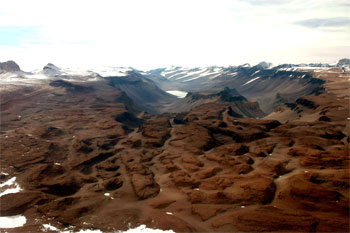Climate change caused dramatic changes in Antarctica 14 million years ago
Climate change caused dramatic changes in Antarctica 14 million years ago
mongabay.com
August 25, 2006
Climate change 14 million years ago produced catastrophic drainage of subglacial lakes in Antarctica causing dramatic changes in the continent’s landscape according to new research.
In the July issue of the journal Geology, Scientists from Syracuse University and Boston University report that the rapid draining of subglacial lakes caused flooding that formed a 50-kilometer maze of canyons in Antarctica’s southern Victoria Land. The research is significant because it suggests what the future could hold should global temperatures continue to climb.
 Six hundred meters wide and 250 deep, the Labyrinth is a maze of canyons in Antarctica’s southern Victoria Land. Its origin has remained a mystery for years. Photo by David R. Marchant. |
The researchers say that the release of an “enormous, forceful volume” of freshwater, like that which occurred millions of years ago, could impact the stability of the East Antarctic ice sheet and disrupt the Southern Ocean circulation, contributing to regional and global climatic changes. The effects could “alter the delicate balance of the Earth’s ecosystems” they warn.
“There is no doubt that global climate change has occurred throughout Earth’s history,” said Suzanne Baldwin, Syracuse University earth sciences professor and director of the Syracuse University Noble Gas Isotope Research Laboratory. “But the current warming trend that we are experiencing is human-induced. We need to act now to reduce greenhouse gas emissions. Global leadership is desperately needed to attack the problem of global warming.”
“There are plenty of steps we can take to reduce greenhouse gas emissions,” Baldwin added. “The public needs to take the opportunity to educate itself concerning what can be done to reduce them. Seeing the movie An Inconvenient Truth’ will give people a better appreciation of the potential problems we will face if we simply decide to do nothing and if the current attitude of business as usual’ prevails.”
Other scientists have warned that global warming could cause glacial meltwater to raise global sea levels by more than 20 feet by the end of the century, inundating island nation and flooding the world’s densely populated coastal areas.
RELATED ARTICLES
Antarctic and Greenland ice sheets are melting find new studies.
Scientists have confirmed that climate warming is changing how much water remains locked in the Antarctic and Greenland ice sheets, according to an article published in the Journal of Glaciology.
Air above Antarctica warming rapidly.
Winter air temperatures over Antarctica have risen by more than 2C in the last 30 years, according to a study by scientists from the British Antarctic Survey. The increase in Antarctic temperature is three times larger than that observed globally over the same time period.
Antarctic glaciers show Earth’s climate system capable of rapid shifts.
Researchers at Syracuse University have determined that glaciers once covered a much larger area of Antarctica than originally thought, suggesting that Earth’s climate system is capable of rapid shifts. Looking at sediments from marine deposits and rock sources on Seymour Island, Syracuse University Professors Linda C. Ivany and Scott D. Samson along with colleagues at the University of Leuven in Belgium and Hamilton College found evidence that glaciers once covered extensive parts of the West Antarctica ice sheet. Previously, scientists had assumed that glaciers were confined to the eastern part of Antarctica, where the biggest ice sheet is today. The findings are significant because they suggest that the climatic response to the drop in greenhouse gas concentrations in the atmosphere 34 million years ago was greater than initially believed.
Antarctica is melting finds study.
The Antarctic ice sheet continues to shrink according to a NASA study released last week. Using data from the Gravity Recovery and Climate Experiment (GRACE) scientists concluded that Antarctica’s ice sheet decreased by about 152 cubic kilometers annually from April 2002 to August 2005, or about 36 times the annual amount of water used by the city of Los Angeles, or 3 months of total water consumption in the United States.
Snow in Antarctic not falling to counter sea level rise.
The most precise record of Antarctic snowfall ever generated shows there has been no real increase in precipitation over the southernmost continent in the past half-century, even though most computer models assessing global climate change call for an increase in Antarctic precipitation as atmospheric temperatures rise.
Number of tourists visiting Antarctica surges over past decade.
The number of sightseers visiting Antarctica has surged 308 percent since 1992 according to figures released in a report by the UN. For the 2004-2005 year, more than 27,000 people visited the icy continent. In coming years, tourists may be increasingly drawn to the remote landscape as it faces the looming threat of global warming which could significantly impact its glaciers, wildlife, and ice flows. In 2002, scientists found that parts of Antarctica had warmed 1.5°C, while earlier this year, researchers reported in the Arctic, sea ice has decreased by about 8%, or more than 380,000 square miles, over the past 30 years and the ocean could have ice-free summers within a century. The sea could Antarctica could face a similar fate.
Long-term cooling driven by Antarctica, not glaciers in Northern Hemisphere.
Researchers from Brown University have reconstructed 5-million years of climate using tiny marine fossils found in mud off the coast of South America. The climate record unearthed by the Brown team is the longest continuous record of ocean temperatures on Earth.
This article is based on a news release from Syracuse University.














